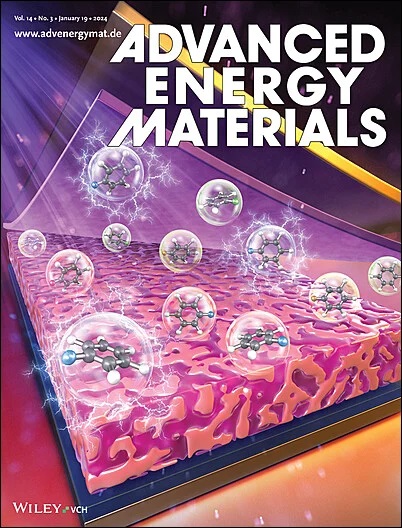Solvent Engineering for Scalable Fabrication of High-Quality Formamidinium Cesium-Based Perovskite Films Toward Highly Efficient and Stable Solar Modules
IF 24.4
1区 材料科学
Q1 CHEMISTRY, PHYSICAL
引用次数: 0
Abstract
Demonstrating the high efficiency and stability of large-area perovskite solar modules (PSMs) is crucial for the industrialization of this innovative photovoltaic technology. However, it remains challenging to achieve the controllable fabrication of high-quality perovskite films over large areas. Herein, a ternary solvent system composed of 2-methoxyethanol (2ME), N,N-dimethylformamide (DMF), and N-methyl-2-pyrrolidone (NMP), is thoroughly investigated to fine-tune the solubility, volatility, and coordination characteristics for formamidinium cesium (FACs) perovskite precursor solution. Initially, 2ME and DMF are employed to adjust the volatility and their coordination of Pb2+ ions, thereby regulating perovskite nucleation rate. Following this, NMP is introduced as a chelating agent to facilitate the formation of stable intermediate phase, which could extend the processing time window for the solution coating and facilitate crystal growth in the subsequent annealing process. With the optimized solvent system, high-quality, large-area FACs perovskite films are successfully fabricated. The resultant inverted PSMs based on a sole NiO hole-transport layer achieved certified efficiencies of 18.73% and 14.62% with aperture areas of 100.15 and 2123.18 cm2. Furthermore, the encapsulated mini-module and sub-module retained 97.2% and 95.8% of their initial efficiencies with maximum power tracking, after aging for 1000 h under 1 and 0.5-sun equivalent white-light illumination, respectively.

用于高效稳定太阳能组件的高质量甲酸铯基钙钛矿薄膜可扩展制造的溶剂工程
展示大面积包晶体太阳能组件(PSM)的高效率和稳定性对于这一创新光伏技术的产业化至关重要。然而,要实现大面积可控制造高质量的过氧化物薄膜仍具有挑战性。本文深入研究了由 2-甲氧基乙醇(2ME)、N,N-二甲基甲酰胺(DMF)和 N-甲基-2-吡咯烷酮(NMP)组成的三元溶剂体系,以微调甲脒铯(FACs)包晶前驱体溶液的溶解度、挥发性和配位特性。首先使用 2ME 和 DMF 来调节挥发性及其与 Pb2+ 离子的配位,从而调节包晶成核率。随后,引入 NMP 作为螯合剂,以促进稳定中间相的形成,从而延长溶液涂层的加工时间窗口,并在随后的退火过程中促进晶体生长。通过优化溶剂体系,成功制备出了高质量、大面积的 FACs 包晶薄膜。基于单一氧化镍空穴传输层的倒置 PSM 的认证效率分别达到 18.73% 和 14.62%,孔径面积分别为 100.15 和 2123.18 平方厘米。此外,在 1 个太阳当量和 0.5 个太阳当量的白光照明下老化 1000 小时后,封装的微型模块和子模块在最大功率跟踪下分别保持了 97.2% 和 95.8% 的初始效率。
本文章由计算机程序翻译,如有差异,请以英文原文为准。
求助全文
约1分钟内获得全文
求助全文
来源期刊

Advanced Energy Materials
CHEMISTRY, PHYSICAL-ENERGY & FUELS
CiteScore
41.90
自引率
4.00%
发文量
889
审稿时长
1.4 months
期刊介绍:
Established in 2011, Advanced Energy Materials is an international, interdisciplinary, English-language journal that focuses on materials used in energy harvesting, conversion, and storage. It is regarded as a top-quality journal alongside Advanced Materials, Advanced Functional Materials, and Small.
With a 2022 Impact Factor of 27.8, Advanced Energy Materials is considered a prime source for the best energy-related research. The journal covers a wide range of topics in energy-related research, including organic and inorganic photovoltaics, batteries and supercapacitors, fuel cells, hydrogen generation and storage, thermoelectrics, water splitting and photocatalysis, solar fuels and thermosolar power, magnetocalorics, and piezoelectronics.
The readership of Advanced Energy Materials includes materials scientists, chemists, physicists, and engineers in both academia and industry. The journal is indexed in various databases and collections, such as Advanced Technologies & Aerospace Database, FIZ Karlsruhe, INSPEC (IET), Science Citation Index Expanded, Technology Collection, and Web of Science, among others.
 求助内容:
求助内容: 应助结果提醒方式:
应助结果提醒方式:


